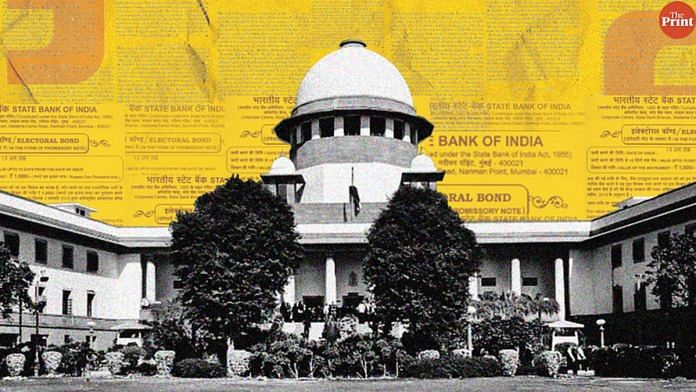The Supreme Court of India, in a landmark judgement delivered on 15 February, declared as unconstitutional the Electoral Bond Scheme brought in 2017 to enable political funding. The main ground was that it violated the voters’ right to information on political funding under Act 19(1)(a) of the Constitution as it lacked transparency. SC opined that anonymity granted for political donations under the scheme promoted corruption and a culture of quid pro quo with the ruling party, not transparency as it was claimed to be, and could lead to “unrestrained influence of the corporates in the electoral process.”
Incidentally, in a communication to the Finance Ministry in 2017, ECI had objected to EBS on the grounds that it would have a “serious impact on transparency of political finance and funding of political parties.” ECI had also pointed out that the removal of the cap on corporate funding would “open up the possibility of shell companies being set up for the sole purpose of making donations to political parties “ and wanted the cap to be reintroduced. ECI took the same stand before the Supreme Court.
The question now is that with the EBS struck down, what steps can be taken to regulate party funding? The answer is provided by the Electoral Trust Scheme (ETS) formulated by the then government in 2013. But the Election Commission found the scheme lacking in transparency, as the source of funding and disbursal of funds to political parties routed through the electoral trusts was not mandated. So ECI, in 2014, by invoking its inherent jurisdiction under Article 324 of the Constitution, issued instructions to all electoral trusts, in the interests of transparency and conduct of free and fair elections, for compulsory disclosure of information of the contributing companies and the beneficiary political parties. Electoral trusts distributed Rs 2,557.74 crore to political parties in the 10 years since 2013-14. But once EBS was introduced, with almost ‘nil’ transparency, contributions under EBS far outstripped the contributions under ETS. As reported by the Association of Democratic Reforms (ADR), between 2017-18 and 2021-22 political parties received Rs 1,631 crore under ETS but a whopping Rs 9,208 crore under EBS.
Though EBS is now gone and the ETS is still available, ECI should take the lead to discuss with political parties and the corporate world and nudge them towards wider use of ETS. Otherwise, political parties can also go the cash route. If successful, at least one part of the electoral funding arena can become cleaner.
Also Read: Electoral bonds can now redeem themselves and Supreme Court. Anonymity cloak set to come off
Candidate spends more than the party
While a sense of euphoria prevails following this judgment, it will do good to have a look at the bigger picture of election expenditure and its funding. Delhi-based think tank CMS India estimated total expenditure in the Lok Sabha election 2019 at Rs 55,000 crore to 60,000 crore. The reported expenditure of all political parties was Rs 2,984 crores for that election, just a fraction of the estimated total expenditure. Thus a large part of the expenditure is actually incurred by the candidates and it is common knowledge that most, if not all, candidates spend monies that are far in excess of the ceiling prescribed.
Anecdotal evidence suggests that approximately Rs 50 crore is spent by each of the candidates from major political parties, i.e. the serious contenders, for a Parliamentary constituency. This figure may vary from state to state. For 543 Lok Sabha seats accounting for approximately 4,123 assembly segments, in a five-year cycle of one election each to assemblies and Parliament, the expenditure by all candidates put together will be upwards of Rs 80,000 crore, on a conservative basis. Major expenditure thus is at the candidates’ level, not that of the parties.
Political parties and candidates no longer have the luxury of dedicated cadres who will stick with them through thick and thin, surviving on ideology and little monetary compensation. Cadres now need to be paid well, and extra hands on the deck during election time costs a tidy sum in terms of food, transport and monetary compensation. Add to this the handouts in cash and kind to the voters that have become de rigueur what with the Tirumangalam formula (2009) from Tamil Nadu spreading to most parts of India.
Contesting elections requires deep pockets, and what candidates spend would be understandably over and above that spent by their respective parties. The enormity of the issue will be clear when we realise that the election expenses figures filed by the parties before the ECI are just a fraction of what the candidates spend and that the latter remains an opaque area. While it is true that the SC judgement has struck a blow on behalf of the right to information of the citizen, it is a sobering thought to note that it won’t even touch the fringe of the problem of lack of transparency in our election expenditure scenario and we cannot be proud of that. Unless our political leadership realises that this cancer if allowed to fester will one day hit at the very roots of democracy and is willing to take corrective steps Amrit Kaal will prove to be a mirage.
Gopalaswami N was the Chief Election Commissioner from 2006 to 2009. Views are personal.
(Edited by Theres Sudeep)



